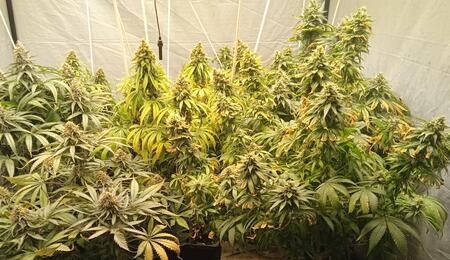How Cannabis Plants Express Themselves - Plant Characteristics and Traits

As a beginner grower, deciding which genetics you want to grow next can often come down to three things. Is the plant indica, sativa, or a hybrid of the two? There is so much more when discussing all the different ways a cannabis plant will express itself, so in this article, I will talk you through each of the traits and desirable characteristics cannabis plants produce, explain phenotypes and give you a full awareness of what to expect from seed until harvest!
Leaf size and shape
One of the main visual factors that will determine what type of cannabis genetics you have, will be down to the leaf size, shape, and pattern. Indica plants will often have a thick, wide fan leaf that can claw over the central parts and need to be removed. Sativa will thin, narrow, and long fan leaves which allow more light to the lower and central internodes.
Growth structure
How a plant grows, during the vegetative stage and over the flowering period, is known as the growth structure of the plant. Not every plant is the same with certain strains such as OG Kush or Zkittles being slow growers and low-yielding genetics, whilst on the other hand, you have strains such as Gorilla Glue and Blue Dream that become huge and require no previous experience. Plant training will also affect the growth structure during 18/6.
Resin production
How many trichomes a cannabis plant will produce from week 3 of flower onwards, is often the unique selling point for connoisseurs, hash makers, and extract artists. Modern-day genetics will serve as the pinnacle of breeding and how frosty a plant will become. Usually, sativa strains do not produce the same amounts of profile of resin as indica or indica hybrids.
Calyx-to-leaf ratio
This simply means how many smaller leaves are surrounding the buds as they mature. A large volume of leaves will make trimming more difficult and longer, and can often lead to problems with mould much faster. Indica cannabis plants will produce dense golf ball buds, whilst sativa will be much more airy, longer, and elongated in comparison.
Aroma and terpenes
The reason why we all love cannabis so much is the fact you can enjoy so many different flavour and aroma profiles. The main flavour profile groups will be fruity, floral, earthy, gas, and exotic candy with everything else falling within those parameters. Old-school strains will lean towards the fruity, earthy, floral, and spicy side of things, with new modern-day hybrids proving a much more intense and exotic profile.
Colour pigment
The colour of the buds and leaves will be different amongst different cannabis genetics, with either green or purple flowers. Some smokers enjoy green flowers and find they offer the most potency than purple strains, whilst others enjoy purple-coloured flowers and find them to be just as strong with effect. The actual purple colour of the buds will be down to genetics and colder temperatures.
Bud structure
You can grow an entire field of different strains, and at the end of the harvest will have either chunky, hard-to-squeeze thumb-sized buds, light and airy less compact buds, and mix in between. If you only want dense buds that are packed full of flavour and resin, then stick with indica, or indica dominant hybrids with a flowering time between 8–9 weeks.
Stretch when flowering
When a timer is switched from 18/6 to 12/12, cannabis plants will produce growth hormones to encourage one final stretch before flowering starts. Plants that stretch too much can be problematic for growers with limited space, or inexperienced with plant training techniques. Indica will usually double in height, and sativa can increase by 300% in some cases.
Flowering time
The flowering time will express how many weeks a cannabis plant takes to produce buds before harvesting. Every seed company will indicate how many weeks of flowering time you can expect, usually ranging from 7 to 12 weeks depending on the variety in question. As a beginner grower, it is well recommended to pick a fast-flowering indica or indica dominant hybrid, as these are low maintenance, easy to control during flowering, and will give you the quickest turnaround time.
Growing outdoors and what to expect
If you get the chance to grow a cannabis plant outdoors from Spring until The Fall, you will notice that compared to a controlled indoor grow room, the plants will express themselves differently.
- Plants will produce much less resin outdoors and even less when inside a greenhouse.
- Internodal spacing will be much larger, resulting in taller plants before flowering.
- Colder temperatures can affect the rate of growth, and colour of the leaves and buds.
- Insects and pests can cause damage to the leaves and buds when flowering.
- Flowering times outdoors can require an extra 7–10 days, depending on the climate.
- Bud density may be less compact compared to indoors and require longer to mature.
- Cannabis plants grown outdoors can be prone to attack from powdery mildew.
- Caterpillars can crawl through the plants and eat the buds, leaving pathogens behind.
- The aroma and terpene profiles will not be as pronounced or intense as an indoor crop.
- Long flowering plants may have difficulty maturing and producing good yields.
What are phenotypes
The easiest way to think about different phenotypes is to imagine you grew out 10 seeds of Afghan Haze. From the 10 seeds, you end up with three different phenotypes that each express themselves definitely in some way, shape, or form. Below is an example of the three phenotypes and how a grower, would then decide which of them is the most practical and preferred choice for their grow room and schedule.
Phenotype #1 (Afghan dominant)
This plant shows Afghan dominant traits, wide and fat-fingered leaves, does not stretch much in flower, and grew to 100 cm tall. Flowering time took 56 days and the buds are golf ball-sized, with trichomes all over and hard to squeeze. The aroma of the buds is earthy and spicy, with a mild fruitiness.
Phenotype #2 (Haze dominant)
The second plant leans on the haze-dominant side and grows with long, thin leaves and double the internodal space of the other plants. This phenotype finished at 170 cm tall and required 73 days before she was ready to harvest. The buds are long and thin and do not have as much resin production as phenotype #1. Aroma and terpenes are much more floral and fruity with hints of spice.
Phenotype #3 (Mix of Afghan and Haze)
The third plant is a mixture of indica and sativa and has a different leaf structure from #1 and #2 with a bushy canopy and growth structure. The height finished at 125 cm tall and had the best yield out of the three plants. The resin production is far superior, and the aroma is a better quality also. The buds are a large size with a low calyx-to-leaf ratio, and when trimming the smaller leaves are packed with trichomes and will make superb hash.
My conclusion
The next time you pick a strain or number of strains to grow, you can go through the above list and decide which desirable traits and characteristics you want. As a beginner, avoid low-yielding strains, long flowering plants, high maintenance sativa strains, and try to pick plants that the breeders say are easy to grow. The more experience you get now with indica and indica hybrids, the better!



